Part of the key to the flag's survival is its construction from "unweighted silk." According to RareFlags.com: One of the most luxurious and expensive of all fabrics, the use of silk in American flags is typically reserved for the finest quality flags, most often for military or official use. Several qualities of silk make it an exceptionally good fabric for use in flags. The material is light-weight, exceptionally strong, tightly woven and weathers well. Its shimmering appearance is beautiful and impressive. For military standards, silk allows for large flags that are light and which dry quickly. The fineness of the material allows for the application of painted decorations, as is often seen in the painted stars and decorative cantons of flags produced for wartime use, especially those of the American Civil War. One unfortunate problem with antique silk flags is that large numbers of them, including many Civil War era battle standards, were made of "weighted silk". Sold for centuries by length, merchants shifted from selling silk by length to selling it by weight, beginning in the early 19th century (circa 1820-1830). In order to earn more money for their silk, merchants frequently soaked the silk in water laden with mineral salts. Once dried, the mineral salts remained in the silk fibers and added weight to the silk, thus bringing the merchant more money. Unfortunately, these mineral salts proved to be caustic and caused severe breakdown in the silk fibers over time. Many flags made of weighted silk are very brittle, often deteriorating under their own weight. Yet flags made of unweighted silk, some of which are decades older than later weighted silk flags, remain in a remarkable state of preservation. Thank goodness the dishonest practice of weighting hadn't begun when this flag was made! Read More: "The Grand Division Standard of the 8th Virginia" More from The 8th Virginia Regiment
0 Comments
Leave a Reply. |
Gabriel Nevilleis researching the history of the Revolutionary War's 8th Virginia Regiment. Its ten companies formed near the frontier, from the Cumberland Gap to Pittsburgh. Categories
All
Archives
June 2024
© 2015-2022 Gabriel Neville
|





 RSS Feed
RSS Feed